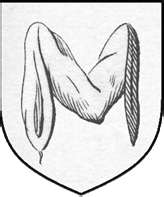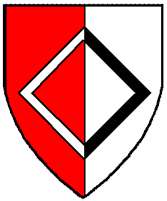
The badge of Sagittary or Sagittarius, the centaur armed with a bow and arrow is attributed to Stephen of Blois and it is thought that this emblem commemorated a victory won by his archers. An alternative theory is that he took his badge from the sign of the zodiac under which his reign began. Another badge said to be used by Stephen was a plume of three ostrich feathers, with the motto, Vi nulla invertitur ordo, “ By no force is their form altered.” This is not to be confused with the ostrich plumes on the Coat of Arms of the Prince of Wales, which are of different origin. The family of Dering from Kent regard the three red roundels (rings) above the blue fess on their silver shield as a memorial of the battle of Lincoln where Stephen was taken prisoner. Normannus Fitz Dering, who made gallant efforts to rescue the King, was found dead after the battle with his shield covered in blood, whence, it is said, the red roundels borne by his descendants. The crest of the family, a black horse, refers to their claim to have been people of note in the old Saxon kingdom if Kent.

MAUNCH
.
MASCLE
Two Coats of Arms give us a glimpse of the styles of clothing and armor that were worn in England in the twelfth century. The first is that of the Hastings family, gold with a red maunch ( a maunch is a lady’s sleeve with a long baggy cuff). William de Hastings, the progenitor of the family, was Steward of the Household to Henry I, in whose reign the illuminations in which we discover this curiously shaped sleeve were, it is most probable, executed. Possibly Hastings adopted this emblem in token of some lady’s favor. A more interesting point for the herald is that in the Hastings shield we have an emblem which seems to have been in continuous use since the reign of Henry I, and is therefore an unusually early example of a personal cognizance which became hereditary. The second hint at old fashions is the shield of De Quincy, Earl of Winchester; red with seven gold mascles ( belt buckles). This device was probably suggested by the armor of the period, which consisted of diamond-shaped pieces of steel superimposed on leather. The mascle also became a very common heraldic device and dates from the time of Henry I.





